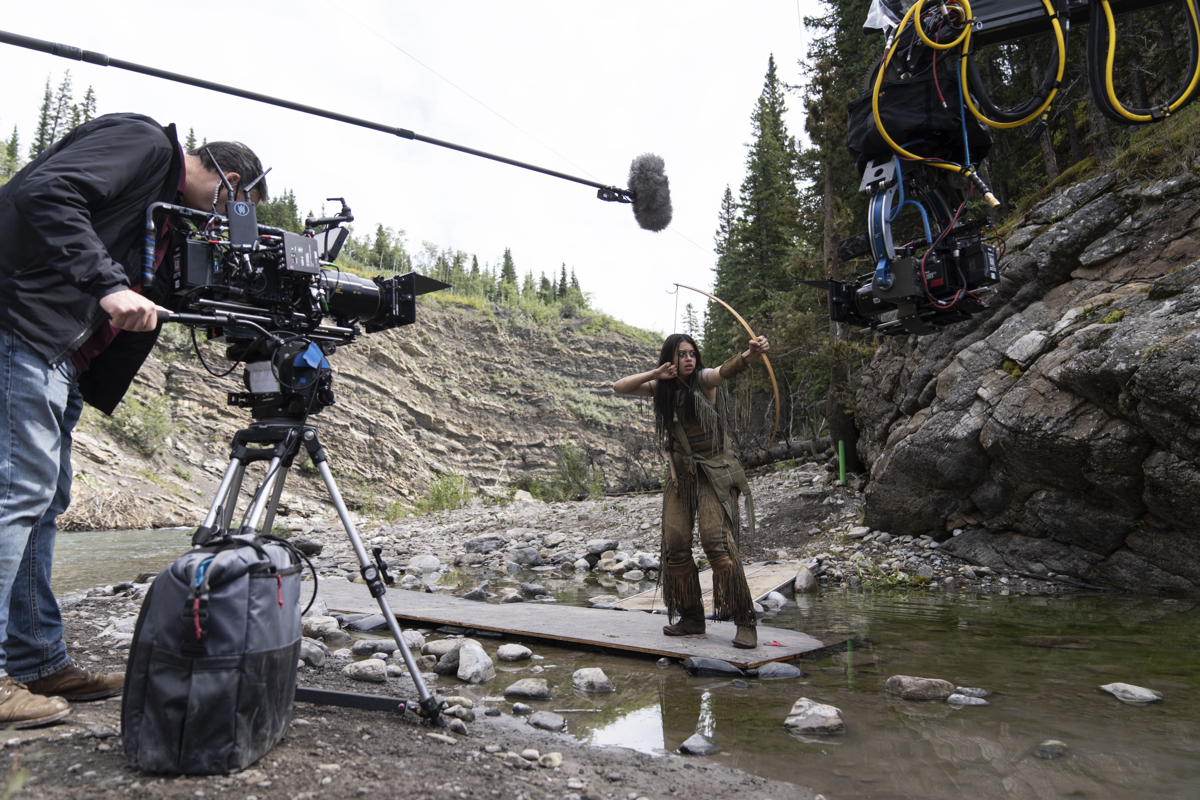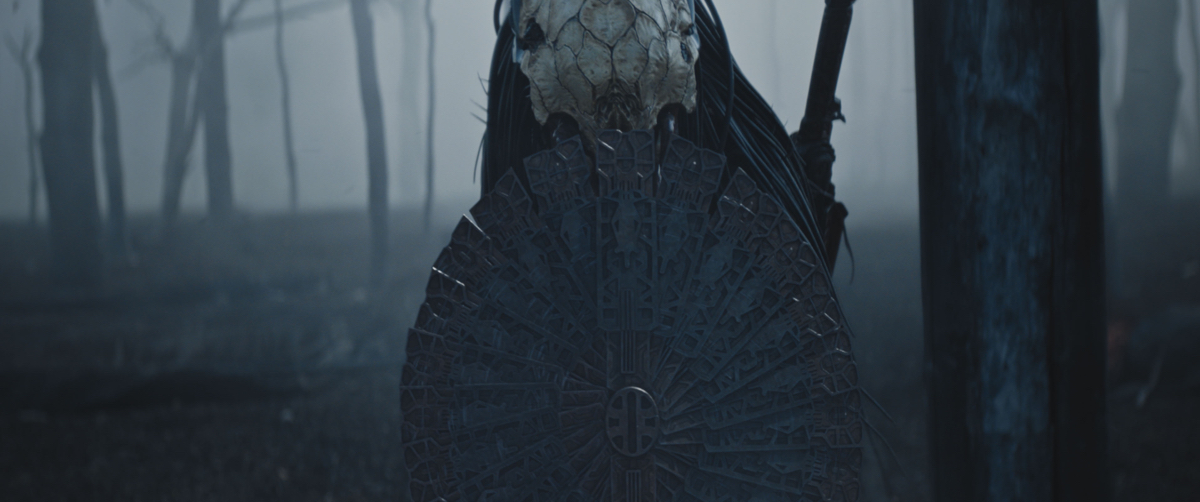Plus, making a bear fight seven-foot-tall alien creature.
Dan Trachtenberg’s Prey, set in the Northern Great Plains in North America in 1719, sees young Comanche warrior Naru (Amber Midthunder) take on a deadly alien Predator.
The Predator creature, as had been done on previous incarnations of the franchise, came to life on set via a man-in-suit, with creature effects overseen here by Amalgamated Dynamics.
As principal VFX vendor, MPC also crafted the Predator in digital form, as well as many of the related effects such as cloaking, glitching and green blood. The studio further realized several CG animals for the film, including a bear that at one point battles the alien.
Here, befores & afters dives into MPC’s visual effects on Prey with visual effects supervisor Chris Uyede.
b&a: What was your methodology for asset builds on the film?
Chris Uyede: We did build a full 3D Predator and we started by using scan data and photography of the animatronic suit built by StudioADI. That design had been established by the production designer and director ahead of time. So, we started by replicating the animatronic suit and then worked up areas that could be enhanced through articulation of things that are hard to do in practical effects. Practical effects are always going to be additive, so we worked on the Predator’s hands, for example, to make them a bit thinner and worked on their articulation, as well as doing some detailing work for the face, removing any seams, et cetera.
We had CG versions of the Predator for a lot of the shots that featured the suit. This was done to support augmentations like seam cleanup, blood tracking, and the Predator is also covered in these metallic scars, so we did a lot of augmentation there.
In some cases, we replaced parts of the Predator’s arms, hands, and face. And then in other cases where we needed to do a superhuman performance, we went full CG on him. We were always as a starting point taking Dane DiLiegro, who was the stunt actor, and his performance. Even on shots where the Predator was fully cloaked, we would normally either have a plate or even mocap of him in shots. Then it would involve breaking it down with our production visual effects supervisor Ryan Cook to figure out which shots would be a full CG Predator and which parts needed a little bit of enhancement.
Anything where we have the cloaked or semi-cloaked Predator, we’d also have to have a CG representation that we’d either have to keyframe or use mocap or just roto-animate and track into the shots.
b&a: With motion capture, was that something done on set or as a separate process?
Chris Uyede: There wasn’t an extensive motion capture shoot after the fact. In shots with the fully cloaked Predator, in some sequences he was on location wearing an Xsens suit.
b&a: I think the world loves the mandibles or the mouth of the Predator. As a creature person, I just assume you would’ve loved diving into the details of that. Tell me about that side of it for MPC, but also about preserving the ‘practical’ feel there. I just feel like whoever got to work on those sorts of things is fulfilling some sort of childhood dream to work on Predator.
Chris Uyede: Absolutely. I think whenever you work on an iconic movie monster like I’ve had the opportunity to do a few times, you have to really get into it and look at some disgusting reference. We had a terrific starting point. We cut back-to-back from the animatronic suit to our full CG Pred to shots where we were just replacing the faces. The suit was so great. So, we started with photography, figuring out where we wanted to enhance it.
There’s a certain level of fidelity that you can get in CG that’s hard to do in silicone. We didn’t change the design from what the suit was, it was just about working out how we could breathe life into it, getting sub-surface transmission in the mouth and trying to articulate the musculature of its face. You get a few really good looks at the unmasked Predator in the film, so that was quite fun. I know that the asset team involved was pretty stoked to get into that, myself included.
b&a: How did you approach the Predator when it’s fully cloaked or partially cloaked?
Chris Uyede: The cloaking was a lot of visual development work. I think the very first test that we did even before the movie went to camera involved the cloak. It’s one of the key features of a Predator movie, of course, is its invisibility cloak, and we went through a lot of rounds of visual development, as well as technical development, on it. We’d look back at the 80s optical compositing, trying to borrow some features from there, looking at what’s been done across the franchise and trying to do something a little bit different. Our Predator’s a little bit different in terms of his camouflage technology.
We looked at all kinds of colors and hex sizes and shapes. What we ended up doing was, for every shot in the movie where there’s a cloaked Predator, there’s actually a CG Predator underneath there. In some cases, it was hand-animated, in some cases it came from motion capture, and then in other cases we just matched closely to the stunt performer.
The cloak in this movie actually sits off of the Predator’s skin a little bit. So, we procedurally generated a surface outside of the Predator and his equipment. In Houdini we then generated a whole number of passes that allowed us flexibility in comp to start to reveal pieces of the Predator, and then also in the reveal or glitch sequences to be able to just produce some of the energy surges that you see moving through it.

b&a: The glitching was really nicely done. What were the challenges of how much to reveal, how much to make it something you could art direct and control?
Chris Uyede: For example, that glitching cloak sequence where the Predator takes out the entire hunting party was one of the big challenges that we had to do. We first had to find a look for it, a color palette that worked. In the last few movies, it’s the classic sci-fi blue. Dan really wanted to get a bit of a different look and so we ended up in the Predator red palette, which I thought was cool. That was a lot of hard work in comp and then also just a lot of procedural passes.
For that whole sequence, even though there was an in-camera Predator for the whole thing, everything that you see in that is a full CG Pred. There were a lot of rounds and iterations on making sure that things like weapons impacts revealed key parts of the Predator so that the audience could follow the action.
b&a: The bear attack is really great. In general for the bear, and for the other creatures, were there stand-ins or stuffies or stunt performers there for reference?
Chris Uyede: Yes, not in all cases, but in some for sure. In the wolf sequence, we intercut between a dog actor, a dog performer, and our CG one. For the mountain lion, it was mostly eyeline sticks. For the bear attack, the shots where Naru is in the beaver dam and her POV is where the bear’s trying to claw its way in, there was a guy in a bear suit to provide that interaction. It was a man in a giant bear suit on a very hot day in Calgary.
bear appreciation post (he’s doing fine) pic.twitter.com/34kDDWC0Ft
— Dane DiLiegro (@DDNumeroUno) August 15, 2022
b&a: Obviously the team there is very familiar with doing creature work, but what did you find were the particular challenges of making a bear in water, with fur?
Chris Uyede: It was an opportunity to make some really striking imagery and it presents pretty much just every visual effect problem that we had on the show bundled into one. We wanted to create something that would fit into the gritty, realistic nature of the film. It’s full CG shots in a lot of cases or some of the plates were shot in a tank on a bluescreen on the backlot. Some of it was on location. We were always trying to fit that altogether.
You don’t often get good reference footage of a seven-foot alien fighting a bear, so we were pushing to just sell the motion as realistically as possible. And then all the layers of simulation on top of that, from the muscle and fat tissue of the bear to the fur, to the water, and try to have all those interact in a convincing way.

b&a: Is Naru’s dog CG at all?
Chris Uyede: No. There was talk of doing a CG version of her dog that never occurred. That dog was all real all the time. It’s another one of the stars debuting in this movie, I think people are really into dogs. The only VFX work that we did for the dog was some lead and safety harness removals and putting a CG rat in its mouth.
b&a: The final fight is clearly a complex mix of stunt choreography and VFX. It loses an arm and there’s lots of green blood. What were the bigger visual effects components of that final fight sequence?
Chris Uyede: For that sequence, we were mixing mostly on-location footage in Alberta with CG. The shield weapon was completely CG throughout the film. We had a CG Naru for when she was launching at him out of the tree. There was obviously a lot of wire work involved that we had to remove. We worked on every shot in the sequence.
Then there was a lot of glowing blood enhancement on Naru, on Predator, the removal of the arm, a lot of face enhancements or replacements, CG weaponry, and a lot of snow continuity.

b&a: I wonder if for the shots involving the blood audiences might think that’s simple, but sometimes tracking that stuff and making it not distracting and art directing it could turn out to be some of the most complex work. Was it?
Chris Uyede: It was definitely labor-intensive. On set they had whatever chemicals are inside a glow-stick for some shots, but that can’t really be used on human skin. So, there was a lot of tracking patches of blood and a lot of discussion about the exact bluish-green glow that we wanted the Pred blood to have. And then there’s also a lot of CG blood. There’s a lot of simulated blood as well as 2D blood elements. A majority of our shots included CG blood or blood augmentation to it, whether it be human, animal, or alien. It was a good opportunity, to work on an actual rated-R movie.


















